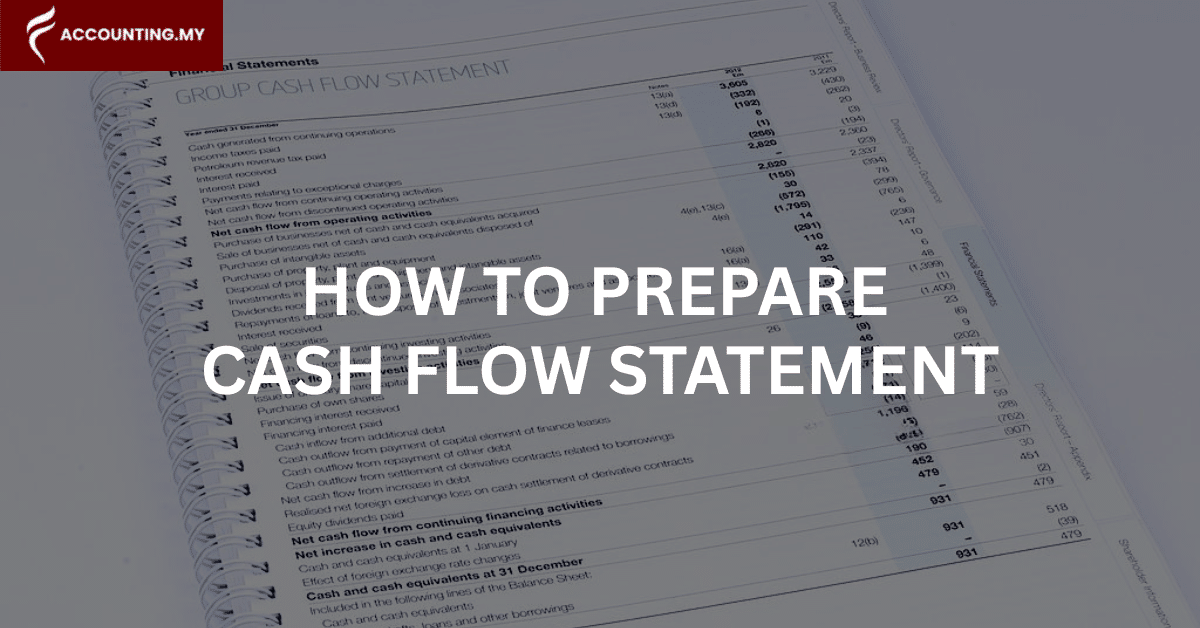Ever wondered where all the money in your business actually goes? You might be making sales and showing a profit, but sometimes the bank balance doesn’t quite reflect that happy picture.
That’s where the cash flow statement comes in. For those just starting out or needing assistance, an accounting firm can provide valuable support in understanding and preparing this crucial report.
But fundamentally, it’s different from your profit and loss account, which can include non-cash items. This guide will walk you through how to prepare one, even if you’re just starting out.
Understanding the Cash Flow Statement
At its heart, the cashflow statement tracks all the cash your business receives and all the cash it pays out. It’s an important tool for understanding your business’ liquidity and its ability to meet short-term obligations.
Knowing your cash flow can help you make smarter decisions, plan for the future, and even spot potential problems before they become serious.
The statement of cash flow is typically divided into three main activities:
- Operating Activities: This section looks at the cash generated from your normal day-to-day business operations. Think about the money you get from selling your products or services, and the cash you pay out for things like salaries, rent, and supplies.
- Investing Activities: This part deals with the cash flow related to the purchase and sale of long-term assets. This includes things like buying or selling equipment, property, or investments.
- Financing Activities: This section covers how your business is funded. It includes transactions related to debt (like loans), equity (like selling shares), and dividends.
Why Bother with a Cash Flow Statement?
You might be thinking, “Do I really need another financial report in my business?” The answer is a resounding yes. Managing the cash flow of your business provides invaluable insights. It helps you:
- See if your operations are generating enough cash to keep the business running.
- Understand how your investments are impacting your cash position.
- Track how borrowing and equity are affecting your cash.
- Plan for future cash needs, like making big purchases or covering seasonal dips in income.
- Present a clearer financial picture to lenders and investors.
How to Prepare Cash Flow Statement
To prepare a for cash flow document you’ll generally need a couple of key financial reports:
- Your income statement (also known as the profit and loss account) for the period you’re analysing.
- Your balance sheets from the beginning and end of that same period.
Having these side by side will make the process much smoother when preparing a statement or enlisting the help of accounting services.
Methods of Preparing a Cash Flow Statement
There are two main ways to put together the operating activities section of your cash flow statement: the direct method and the indirect method.
- Direct Method: This method directly shows the actual cash inflows and outflows from your operating activities. For example, instead of just showing sales revenue, you’d show the actual cash received from customers.
- Indirect Method: This method starts with your net profit (from the income statement) and then makes adjustments for non-cash items and changes in your working capital accounts (like accounts receivable and accounts payable). This method is more commonly used.
For beginners, the logic of the direct method can be easier to grasp initially, but the indirect method is often more practical as the information is readily available from your other financial statements. We’ll focus on the cash flow statement indirect method.
Step-by-Step: Preparing a Cash Flow Statement Indirect Method
Here’s a breakdown of the steps involved:
1. Start with Net Profit
Take your net profit figure from your income statement. This is your starting point. Remember, net profit can include non-cash items, so we’ll need to adjust for those.
2. Adjust for Non-Cash Items
Add back any non-cash expenses that were deducted in calculating your net profit. The most common one is depreciation (the wear and tear on your assets). Other examples can include amortisation and losses on the sale of assets.
Amortisation is like gradually using up the value of an intangible asset, like a patent, over its useful life. Instead of expending the full cost immediately, you spread it out over time, similar to how you use up a season pass.
3. Account for Changes in Working Capital
This is where we look at how changes in your current assets and liabilities have affected your cash.
- Increase in Current Assets (like Accounts Receivable or Inventory): This generally means you’ve used cash, so you’ll subtract this increase. For example, if your customers owe you more money at the end of the period than at the beginning, it means you haven’t yet received that cash.
- Decrease in Current Assets: This generally means you’ve received cash, so you’ll add this decrease.
- Increase in Current Liabilities (like Accounts Payable): This generally means you’ve held onto cash for longer, so you’ll add this increase. For example, if you owe your suppliers more money at the end of the period, it means you haven’t paid out that cash yet.
- Decrease in Current Liabilities: This generally means you’ve paid out cash, so you’ll subtract this decrease.
Here’s a simple table to summarise the adjustments for working capital:
Account | Effect on Cash Flow (Indirect Method) |
Increase in Current Assets | Subtract |
Decrease in Current Assets | Add |
Increase in Current Liabilities | Add |
Decrease in Current Liabilities | Subtract |
4. Calculate Cashflow from Investing Activities
This section is usually straightforward. List the cash inflows from selling long-term assets (like equipment) and the cash outflows from buying them.
5. Calculate Cash Flow from Financing Activities
Similarly, list the cash inflows from activities like taking out loans or issuing shares, and the cash outflows for repaying loans or paying dividends.
6. Putting It All Together: The Cash Flow Statement Format
The cash flow statement format typically looks something like this:
Particulars | Details | Amount |
Cash Flow Statement | ||
For the Period Ended [Date] | ||
Cash flow from operating activities | ||
Net profit | £XXX | |
Adjustments for non-cash items: | ||
Depreciation | £XXX | |
Adjustments for changes in working capital: | ||
(Increase)/Decrease in Accounts Receivable | £XXX | |
(Increase)/Decrease in Inventory | £XXX | |
Increase/(Decrease) in Accounts Payable | £XXX | |
Increase/(Decrease) in Other Current Liabilities | £XXX | |
Net cash from operating activities | £XXX | |
Cash flow from investing activities | ||
Proceeds from sale of equipment | £XXX | |
Purchase of property, plant, and equipment | (£XXX) | |
Net cash from investing activities | £XXX | |
Cash flow from financing activities | ||
Proceeds from new borrowings | £XXX | |
Repayment of borrowings | (£XXX) | |
Dividends paid | (£XXX) | |
Net cash from financing activities | £XXX | |
Net increase/(decrease) in cash and cash equivalents | £XXX | |
Cash and cash equivalents at beginning of period | £XXX | |
Cash and cash equivalents at end of period | £XXX |
You can certainly create this in a spreadsheet program like cashflow statement format in Excel. Setting up the formulas to automatically calculate the net cash flow for each section can save you time.
Tips for Preparing Your Cash Flow Statement
- Be Consistent: Stick to the same accounting period for all your financial statements.
- Double-Check Your Figures: Accuracy is key. Make sure the numbers you’re using match your income statement and balance sheets.
- Understand the Logic: Don’t just plug in numbers. Try to understand why certain adjustments are made.
- Use Software: Consider using accounting software. Many packages can automatically generate a cash flow statement for you once your other financial data is entered.
Conclusion On How to Prepare a Cash Flow Statement
The cash flow statement provides a view of a company’s ability to generate cash and how it uses that cash.
Preparing a cash flow statement might seem a bit daunting at first, but with a systematic approach and a basic understanding of the principles involved, it becomes a valuable tool in your financial toolkit.
However, if navigating the intricacies of cash flow statements feels overwhelming, remember that expert help is available.
At Accounting.my, our experienced accountants are well-equipped to handle cash flow statement preparation, along with a full spectrum of accounting needs, allowing you to focus on growing your business with financial peace of mind. It offers a perspective on your business that your profit and loss account alone simply cannot provide.
So, take the time to learn this essential skill – or reach out for professional assistance – your business will thank you for it.
Frequently Asked Questions About Cashflow Statement
No. The cash flow statement shows the movement of actual cash, while profitability is reflected in the income statement, which can include non-cash items.
Businesses typically prepare cash flow statements monthly, quarterly, and annually to track trends and manage cash effectively.
Yes. A profitable company or business can experience negative cash flow due to large investments in assets or increases in working capital that tie up cash.
No. Depreciation is a non-cash expense that reflects the wearing out of assets. It's added back in the indirect method as it reduced net profit without involving a cash outflow.
By analysing past cash flow patterns, businesses can better predict future cash inflows and outflows, aiding in financial planning and budgeting.
Generally, publicly traded companies are required to prepare a cash flow statement. Smaller, private businesses might not always be legally obligated but often find it a valuable management tool.















